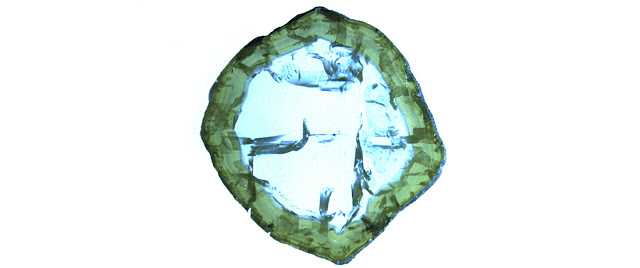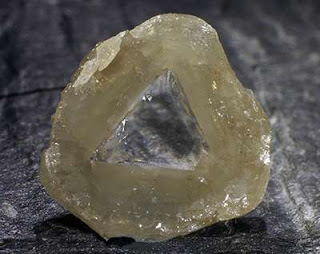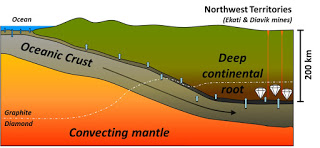
Some of the rich diamond deposits in the Northwest Territories may have been formed as a result of ancient seawater streaming into the deep roots of the continent, transported by plate tectonics, suggests new research from an international team of scientists in Canada, the U.S. and the U.K. The discovery further highlights the role played by plate tectonics in “recycling” surface materials into deep parts of the earth, building on the groundbreaking discovery by a University of Alberta team last year of vast quantities of water trapped more than 500 kilometres underground.

“With the ringwoodite discovery, we showed there is a lot of water trapped in really deep parts of the Earth, which probably all came from recycling ocean water,” explains Graham Pearson, professor in the U of A’s Department of Earth and Atmospheric Sciences and Canada Excellence Research Chair in Arctic Resources. “This new study really highlights that process—it clearly demonstrates that ocean water in this case has been subducted via an old oceanic slab into a slightly shallower but still very deep part of the Earth. From there it has pumped that brine into the bottom of the root beneath the Northwest Territories, and it’s made the diamonds.”
Ugly diamonds are a researcher’s best friend
The Northwest Territories is home to rich deposits of high-quality gem diamonds as well as so-called “low-quality” diamonds, which are covered in a coat of cloudy material. “They’re kind of ugly things,” laughs Pearson. “But all the most interesting diamonds are.”
All diamonds are formed from fluids, but only these less attractive coated stones still contain traces of their scientifically valuable source fluids. “[The fluids in the coats] are sky-high in sodium and potassium and chlorine, and it’s very difficult to get that stuff from the Earth’s normal mantle,” says Pearson. “It’s a big mystery—where does that come from? Well, we can show that maybe the most sensible place for it to come from is seawater, which is basically a sodium chloride solution.”
Pearson notes that this captive seawater likely became trapped in a massive slab of the Earth’s oceanic crust that was subducted beneath North America some hundreds of millions of years ago. The interaction of these seawater brines with the overlying mantle rocks produced a chemically diverse range of fluids from which diamonds crystallized, and could then be carried back to the Earth’s surface via an erupting host volcanic rock known as a kimberlite. These fluid-rich diamonds provide scientists with the most pristine examples of deep Earth fluids—from around 200 km beneath Earth’s surface.
“The beauty of the diamond is that because it’s such a robust capsule, it protects the material that it trapped at that depth from any subsequent change,” says Pearson. “It literally carries pristine bits of material from right where it came from, essentially unchanged.”
New facets of understanding

Although high-quality gem diamonds are normally estimated to have been formed three billion to 3.5 billion years ago, these poor-quality, fluid-rich diamonds appear to be just a few hundred million years old—significantly younger in the Earth’s geological timeline. One theory to explain this age difference is that the two types of diamonds are actually formed by similar processes, and then over time the fluid-rich stones transform into the gem diamonds. Pearson and his team plan to do further studies on the fluids found in these diamonds to test this model.
“What we appear to be finding more and more is that the standard model that used to be around—diamonds are only formed in very ancient times, 3.5 billion years ago, by a very specific process—is not true,” says Pearson. “There are more processes that form diamonds at a whole range of different times than we thought possible.”
Understanding more about how diamonds form can shape exploration models of how to find them, offering clues to help locate further deposits. Canada is the world’s third-highest diamond producer by value, and the majority of the product is retrieved from the Northwest Territories, where mining is a significant contributor to the province’s economy.
The findings of the study were published in Nature.
Reference:
“Highly saline fluids from a subducting slab as the source for fluid-rich diamonds.” Nature 524, 339–342 (20 August 2015) DOI: 10.1038/nature14857
Note: The above post is reprinted from materials provided by University of Alberta.










